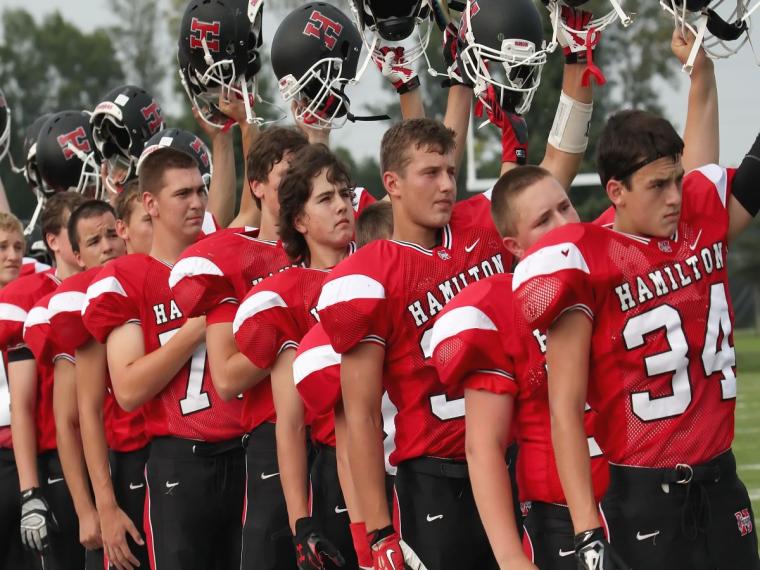

A few years ago, the biggest worry was a dip in the number of high school boys playing football. Because the sport had been perennially popular up until then, the loss of players for three straight school years was attributed to the attention being paid to concussions.
(There will now be a moment of silence to memorialize the death of our innocence, a casualty of the pandemic).
And although there wasn’t much good news, youth sports-wise, to come out of 2020, the downward trend in fall high school football participation did show a marked decrease, leading officials to believe that not only did kids want to play but their parents appreciated the many concussion protocols that had been put in place and were ready to send them back on the field.
Of course, that encouraging development was the last thing positive to happen before COVID slammed the brakes on everything else.
Fast-forward to 2021, though and it appears that football’s forward momentum not only has not been lost but is continuing. The National Federation of State High School Associations (NFHS) has an all-out promotion to bring the sport back nationwide this coming fall in all 50 states.
“A full return to high school sports and performing arts programs – that’s the hope for this fall in schools across the country,” noted NFHS executive director Dr. Karissa Niehoff in a recent announcement. “After a year of unprecedented challenges in keeping these programs going due to the pandemic, which included 11 states that conducted their primary football season this spring, there is great optimism as we look to a new school year. Even in those states that were able to conduct activities last fall, attendance restrictions kept many fans out of stadiums and watching games online. However, with vaccine eligibility now at 12 years of age and older and with vaccinations continuing during the next three months, the likelihood of routines and traditions returning this fall grows stronger each day.”
The indicators, even as far back as a year ago, have been there, showing students’ continuing interest in playing. In Connecticut, independent leagues allowed high school football to play (even if teams had to be fielded wearing jerseys that did not list their schools). The AAU, meanwhile, began conducting football championships in early 2021, and has more on the books for the coming fall.
The college level is also showing its strength. The Magic City Classic, a tradition among historically black college and university (HBCU) football programs, is on the books for Alabama in October. The Magic City Classic is the largest HBCU football game in the country. Alabama A&M University and Alabama State University play in the game annually at Legion Field in Birmingham, Alabama, and the winner could potentially earn a spot in the SWAC Championship. Festivities surrounding the game include the Classic Kickoff, Magic City Classic Parade, Tailgate Party and the famed halftime show performed by the Mighty Marching Hornets and the Marching Maroon and White.
And at the NCAA level, there is also cause for celebration. The 2021 NCAA Division I Football Bowl Subdivision (FBS) football season, the 152nd season of college football in the U.S., is scheduled to begin on August 28, 2021, and end on December 11, 2021.
And at the high school level, there has been a flurry of activity among students who want to get noticed by scouts for college programs. During the pandemic, when opportunities were limited not just to play but to play in front of spectators, students connected with college coaches using software platforms like CaptainU and Next College Student Athlete, which allowed them to upload videos of themselves playing and to showcase the skills they could bring to the school. Live streams were also more in demand. Expect the reliance on technology to continue; it might be one of the few good things to come out of the pandemic.
Another good sign? Combines and showcase camps for high school students are starting up. Expect these to have absolutely explosive attendance this year as students begin vying once again for the eyeballs of coaches and scouts. And with a vaccine available to students, count on an enhanced comfort level that could even drive a demand for more showcases, camps and combines.
The NFHS is optimistic about participation numbers in varsity football alone.
“This fall, we anticipate a return to the energy and excitement of the 2019 season when 1,003,524 boys participated in 11-player football,” said Niehoff in a formal statement. “That total marked a decline of only 2,489 from the previous year and was a good sign of a renewed confidence on the part of parents and student-athletes that concerns about the risk of injury were being addressed. While boys participation in 11-player football has exceeded one million participants every year since 1999 and is overwhelmingly the most popular boys sport, there have been concerns about declines in past years.”
Through a partnership with the NFL, NFHS worked to raise parents’ attention to the many steps that had been taken to ensure students’ safety – and judging by the slowdown of players leaving the sport, it appears to be working.
NFHS will begin its social media blitz as well, with the launch of the #ThisIsHSFootball campaign, and Niehoff notes, “Through this effort over the next few months, the NFHS will be reaching out to coaches, students, parents, officials, athletic directors and others with research information, participation trends and data on various risk mitigation efforts that, we believe, continues to make high school football safer than it has ever been.”
